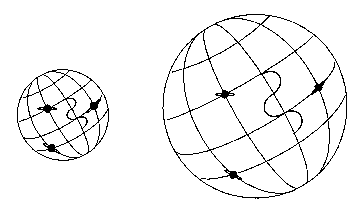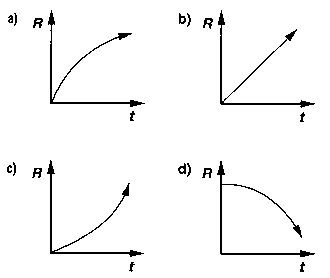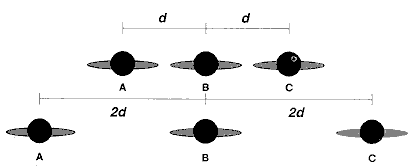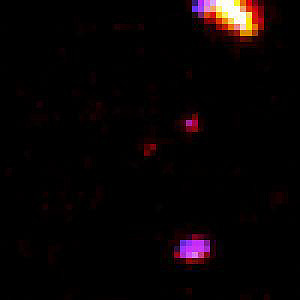
Shifting our attention to the space generation aspect of the Big Bang model: The Bang effect, starting from a singularity, requires that the matter created (photons, atoms; subatomic particles) move apart systematically in a continuously expanding Universe. Galaxies, holding most of the condensed products (gas; dust) of this matter, are receding from one another over a range of velocities (as demonstrated by the spectral red shift phenomenon [see next page]) that depend on their relative proximities and on their apparent ages as a function of distance. The apparent age of a given galaxy (most galaxies formed early in cosmic time [first 1 - 3 b.y.], but many continue to generate new stars, and some may have formed later or may even still be forming anew) when the astronomer sees it is just the time elapsed for light to have traveled (at ~300,000 km/sec [186,000 miles/sec]) the total distance it is now from Earth; thus, if it shown (see next page) to be 9 billion l.y. away today (a distance of ~1023 kilometers), light has taken that long to get here and the galaxy must therefore have been in existence at least 9 b.y ago. We see this galaxy as it was then, in an early or younger stage of development, not as it has since become in our time. (Obviously, if what the astronomer sees is a well-formed galaxy, it will be considerably older now since some minimum time [estimated few hundred million years] is needed to reach that state from a primitive starting point.) Of course, it and the Earth (within the Milky Way) were much closer to each other 9 b.y. ago and have continued receding from one another since. In the early moments of the Big Bang, the two galaxies were indeed very close, as were all galaxies including those now at maximum observable distance from Earth; since then the two have separated a distance specified by that covered by their mutual travel in 9 billion light years of expansion. This seeming paradox is addressed by applying Einsteinian concepts of gravitationally moderated space-time (his theory of General Relativity). The age we assign to a galaxy at any distance from Earth depends on its distance (in light years) and the age chosen for the beginning of the Big Bang. To calculate this: Age we now see = Stage of Development = Age of Universe - Time elapsed during the travel time of light [l.y.] from galaxy to us. Assuming the Universe's age to be 15 Ga (remember, a Ga refers to Giga-annum or a billion years), the galaxy 9 Ga away shows us today what it looked like at 15 - 9 = 6 Ga after the Big Bang.
Let us reiterate the above ideas for emphasis. One consequence of this picture of the space-time distribution of galaxies is this: galaxies farthest away, say 10-15 billion light years, are among the oldest in the Universe. What we see of these distant objects is their status or appearance at that time, when they were young; we can make no statement about their condition today. As the distance between Earth and the galaxies we choose to observe becomes progressively less, in terms of light years, we see them as ever further along in their evolutionary history (assuming that the vast majority of galaxies formed during the first several billion years since the Big Bang). Thus, those situated closer to Earth require shorter light travel times to display their appearance and thus show their development at earlier times. So, a galaxy shown to be 3 billion l.y. away is sending light and other radiation that left it three billion years ago, when it is likely at a much later time in its evolution.
From the grand concepts of Relativity (perhaps the greatest "thought" so far in the 20th Century), it is concluded that space itself is the entitythat is doing the expanding rather than just the matter within it simply flying apart. As expansion proceeds, the light traveling from one galaxy to another distant one is "stretched" out (thus assuming longer wavelengths, as described by redshift process [next page]). Thus, both evermore new space and the matter it will contain can be said to be "created" and organized from the events ordained by the Big Bang. The expansion of space is four-dimensional (3 spatial and one time dimension). It is important to note that, while space is the entity doing the expansion, there is no corresponding expansion within galaxies (their stars are not drawing apart, and in fact over time they tend to contract as the stars move inward towards the usual Black Holes at their centers). It is impossible to draw upon ordinary visual experience to envision this expansion but the analogy described in the next paragraph can be useful.
Thus, to help picture in one's mind the more abstract 4-dimensional expansion of the Universe, the example is often cited of the spreading apart of polka dots on a balloon's surface that is progressively enlarged as the balloon is inflated. This analogy is a good working description of one mode of the enlargement of space (spherical) if one simply ignores the everyday experience of a balloon having an interior - instead think only in terms of its surface. A sphere has the special property of being dimensionally finite but has no edge as such; it curves continuously on and through itself. In the balloon example, its surface is in effect a 2-D curved surface.The balloon's surface can be thought of as representing an the surface of an expanding sphere on which the Universe's components - galaxies, intergalactic matter, "empty" space between stars and between galaxies, radiation - are located. There is nothing outside the balloon (Universe) nor anything within the sphere - also non-space. The universal space being generated associates with the equivalent balloon surface (however, the galaxies, unlike the dots, do have dimensional depth). (A word of caution: other expansion geometries - hyperbolic and flat - are possible and lead to different end results, as discussed on the next page.)
For the Universe, any point on the sphere is equivalent to any other point but the idea of a center on the sphere itself has no meaning. Only when one point (such as Earth) is chosen as an observing reference does any meaningful framework of space-time geometry have any value in discussing "location". Earth, in Babylonian and Ptolemaic models, and in those adopted by Christian theology, was once held to be the center of the Universe. Later, the Sun was accepted as center. Now it has become obvious that our solar system occupies a non-important position part way out from the central region of our Milky Way galaxy. This galaxy is as typical ("normal") as most others in the Universe. Its location within the Universe cannot be specified with respect to an ultimate center, since none can be found. (Thus, some civilization on a planet around a star in a distant galaxy would likewise see themselves as apparently at the center of their perceived Universe). But, again, no real center can be fixed anywhere since all points on the expanding geometry (see next page for the spatial alternatives, which include non-spherical and contracting models) have equal weight and significance. In a sense, the fourth dimension has a "center", namely the singular point in time when expansion began.
This notion of expansion can also be visualized with the help of this diagram which presents the process as a 2-D portrayal using circles (the concept depicted works just as well for the 3-D [balloon] version):

The circle on the left depicts a sphere with a radius r1 on which a coordinate system (essentially, latitude and longitude lines) has been traced. That describes expansion from an initial point (radius r0). As expansion continues, the circle on the right now has a radius r2. The coordinate system has correspondingly expanded so that the coordinates of any point, such as locate any of the three "Saturn" discs (note that they remain constant in size even as they separate; this is analogous to the above-mentioned statement that galaxies do not expand in proportion to space expansion), have changed only in scale. From this one can define a basic function called the Scale Factor, given by the symbol R, which describes the changes in lengths on an expanding system as a function of time. This simple equation applies: R(t) = rn/r0, where rn is the radius at some specific time and r0 is the initial radius (for the Universe, the singularity point). Thus, the amount or rate of expansion (or contraction) can be adjusted by a given Scale Factor; if not defining a linear function one value will yield a faster (slower) rate than another that is numerically less (greater). For a given span of time, separations (length spreads) will be greater for higher R's than lower ones. The coordinates are said to be comoving, that is, they enlarge during expansion but all x, y, and z points referenced to them scale proportionately with R while maintaining their same relative positions. The Scale Factor is a fundamental geometric property that is relevant to a description of an expanding Universe.
Four general modes of change of R with time are depicted in the next diagram.

Graph a shows a decreasing rate of expansion, b a uniform or constant (linear) rate, c, an increasing rate, and d a negative rate of expansion (i.e., a contraction).
Note that for a given increase in expansion over some time from t1 to t2, points that are farther apart at t1 expand at progressively greater velocities than those nearer each other; thus, they cover greater distances in a unit of time (we shall see on the next page that this ever increasing velocity outward is associated with progressive increases in wavelengths of light as shown by the redshift phenomenon). A simple way to visualize that idea is to carry out this rubber band experiment: Take a wide rubber band and penmark five marks on it - one [make it an X] at the center as a reference, then one dot on either side an inch apart and one more dot on each side separated by another inch from each of the inner paired dots; holding the band around your two forefingers, gradually stretch the rubber band outwards about three inches and observe the shifts of the dots against a backdrop of a ruler, placing and holding the center X at some number; the two inner dots move some distance and the two outer dots also move but over a greater distance; also, the increase in separation between inner and outer dot on either side is larger than between the X and inner dot; since velocity (v) = distance (d) divided by time (t) and the time of the stretch was the same for all dots, the outer dots are said to move apart at a greater velocity than the inner pair; this is a relative effect since any set of points along the rubber band do not actually move at different speeds as it pulls apart. This manner of motion is inherent to cosmological expansion; otherwise, if all points expanded at the same velocity along radii of a sphere from a common starting point, all would simply migrate outward as an expanding shell creating an increasing void bounded by their inner edge (here, the balloon analogy may help to picture this).
This can be further elucidated with this diagram:

Let the upper row represent the position of three galaxies at t1 and the lower the later expanded location at t2. The elapsed time is (t2 - t1) = Delta t. Initially, each galaxy is separated by a distance d. Following expansion, A is now separated from B by 2d and from C by 4d. Therefore B has moved with respect to A (the observation position) at a recessional velocity (d/t) of (2d - d)/Delta t = d/Delta t and C from A at (4d - 2d)/Delta t = 2d/Delta t. Thus, the velocity of recession of C with respect to A is twice that of B to A. (Returning to the balloon analogy, one can see that farther dots recede faster than closer ones relative to some dot chosen as the point of observation.) The relative velocities will depend on the Scale Factor. As determined from red shift studies (next page), in this dynamic Universe any two galaxies are moving relative to one another at different recessional velocities which depends on their distance apart; the velocity between one of these galaxies and still a third that is twice as far away will be double (twice) that of the first pair considered.
The more distant galactic objects detected so far (by the Hubble Space Telescope [HST]) are at least 7 billion light years, and some perhaps 10-12 or more billion l.y., away from us. A recent report claims that HST has now found galaxies whose redshift distance calculates out as 12 billion l.y.; these are so faint that the view seen here represents an exposure time of 36 hours as the NICMOS (Near Infrared and Multi-Object Spectrometer) gathered radiation from a very narrow field of view pointed near the top of the Big Dipper.

What is beyond this current observed limit is still unknown but should someday be determined by better radiation-gathering instruments. It is worth mentioned at this point three attributes of the status of the farthest out galaxies deep-space imagery, already alluded to: 1) during the 12 billion l.y. transit time, both the Earth (receiving end of signal) and the galaxies (source or sender) have been receding from each other; 2) since the best estimate of time zero at the Big Bang is currently being stated as 15 billion years, it follows that the outer limit (if such exists for a finite Universe) is still beyond the reach of our observation capabilities, and 3) the galaxies seen here are in the stage of development as they were 12 billion years ago and today have evolved through that time span to states we can only conjecture about.
This next illustration is a panorama of galaxies imaged by HST in which some of the light points are located in what has been called the Deep Field region.

The apparent 2-D aspect (i.e., flat; lack of depth) of this image is misleading in that many of the galactic bodies (stars cannot be resolved) - generally, the ones appearing to be larger, with discernible structure - can be shown to be relatively close. Size, then, is mostly a function of distance although galaxies do vary in dimensions to some extent. Most of the smaller ones may be 6 to 9 billion light years or more away. Those objects farthest way - near the edge of the (so-far) observed Universe - appear as tiny blue specks (about 1,000,000,000 times fainter than can be detected by the human eye); their red shifts (see next page) of greater than 3-4 indicate them to be the fastest moving in the expanding Universe as predicted from the Big Bang model.
A few of these extremely distant objects may well be galaxies that formed in the first billion years. An example below (which also illustrates how the Hubble scientists go about the process of making their observations and drawing their deductions) shows a small region of the Deep Field (and several closer galaxies) as imaged by HST in four radiation bands from the UV to the Near-IR.

The arrows point to a location within this region in which no object appears in the left three panels (UV and two visible bands) but a dark spot under the arrow in the right panel (Near-IR) shows an object (presumably a galaxy) in that position. Its red shift (see next page), now out of the visible red into the near infrared, is great enough (> 5) to fit an object near the time-space edge of the Universe corresponding to the earliest period of galaxy formation. Thus, detection of very distant galactic objects is very much dependent on wavelengths sampled.
As the galaxies began to form and afterwards evolve - producing visible entities whose relative motions with respect to one another can then be monitored - they all continued the earlier expansion motions imposed since the Big Bang. This, in effect, means that they are all moving generally in the direction of expansion while at the same time are each moving apart from its neighbors (thus, all galaxies tend to spread apart from one another, although they occasionally can cross paths and collide). In any (and all) region(s) of the Universe, such as the Local Group which contains our Milky Way and many nearby galaxies, the movements of these galaxies, while expansive overall, tend to be in various directions including towards one another (thus ensuring some collisions), but with the majority outwards. A few, such as Andromeda, are currently moving towards us. And whenever galaxies that form a group or cluster are examined, some proportion of the total will show shifts towards the blue (not necessarily into the blue). This multi-directional motion pattern results from gravitational interactions that mutually perturb their relative movements (see the bee analogy below). This is observable only nearby; at great distances the net red shift swamps any variation caused by more immediate conditions around the observed galaxy(ies).
We can gain a better insight into several of the ideas expressed on this page by drawing upon another analogy. This is quoted directly (p. 61) from Joseph Silk's The Big Bang, 1989 (comments in parentheses are the writer's [NMS]):
" We can try to visualize the initial expansion (of the Universe) by imagining an immense swarm of bees (matter; later, the galaxies) crammed into a tiny hive. Suddenly the beekeeper removes the hive, and the bees rush off in all directions (at once). Any given bee will observe its neighbors to be moving away from each other. Suppose all the bees fly in straight lines but in random directions. The swarm of bees will steadily spread out, covering an ever-increasing volume, and the fastest bees will be farthest away. A simple relation connects the velocity of any bee with the distance traveled." To this I add: there always remains some bees close-in to the hive site; and some bees don't get too adventurous and start flying at greater speeds past other bees further out, i.e., they elect to stay in their relative positions after release. And, like the bees, within galaxy clusters, the net motion of individual galaxies tend to be in all directions (i.e., random) including some coming towards Earth even as the cluster groups themselves are moving both outward and apart.
To sum up, General Relativity demands some degree of curvature for expanding space. This is controlled by the balance of gravity against the forces imposed by the initial Big Bang. The distribution of matter determines the geometry of space. Space in some way will curve back on itself, maintaining the requirement that it has no (edge) boundaries. If space completely curves back on itself, the Universe is closed; if curved in other ways, it is open. We can only see that part of the (visible) Universe in which light has had time to get to our observing station. In any mode obeying General Relativity that recognizes perpetual expansion, the Universe will be infinitely large; this means that it will grow continuously forever. As time from the present moves onward, we will see further beyond the present horizon; thus in another billion years, the Universe will be at least that much larger by the amount of expansion that has taken place in this interval and the most distant galaxies will then be a billion light years further "out" than their equivalents today.
Code 935, Goddard Space Flight Center, NASA
Written by: Nicholas M. Short, Sr. email: nmshort@epix.net
and
Jon Robinson email: Jon.W.Robinson.1@gsfc.nasa.gov
Webmaster: Bill Dickinson Jr. email: rstwebmaster@gsti.com
Web Production: Christiane Robinson, Terri Ho and Nannette Fekete
Updated: 1999.03.15.